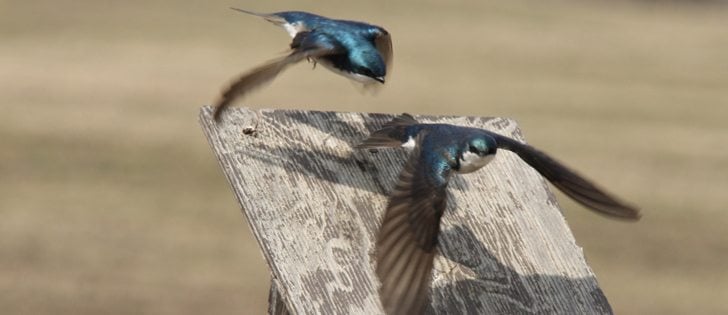Scientists have conducted dozens of studies on neonicotinoid seed treatments and the potential impact on bee health.
Now, researchers at the University of Saskatchewan have found that canola seed coated with imidacloprid, a type of neonicotinoid, can be toxic to songbirds.
“Imidacloprid dosed birds exhibited significant declines in fat stores and body mass and failed to orient correctly,” the scientists wrote in a study published Nov. 9 in the journal Scientific Reports.
“These results suggest that wild songbirds consuming the equivalent of just four imidacloprid-treated canola seeds… per day over three days could suffer impaired condition, migration delays and improper migratory direction, which could lead to increased risk of mortality or lost breeding opportunity.”
Neonicotinoids, also known as neonics, are applied as a seed treatment to almost all of the canola and corn grown in North America and a portion of the soybean crop. The insecticides have been controversial, for years, because research suggests a link between neonics and bee colony losses.
Christy Morrissey, a U of Sask environmental toxicologist, wanted to know if neonics had an impact on songbirds.
Morrissey and her team fed imidacloprid-treated seed to white-crowned sparrows, a type of songbird, and compared the sparrows to a control group.
They also fed the sparrows granules of chlorpyrifos, an organophosate insecticide sold as Lorsban.
In a statement the scientists said the doses were realistic exposure for songbirds, which stop and feed on farmland during spring migration.
“What surprised us was how sensitive and rapid the effects were, particularly to imidacloprid,” Morrissey said in a statement. “The birds showed a significant loss of body mass and signs of acute poisoning (lethargy and loss of appetite). The migration trials also showed that birds completely failed to orient or changed their northward orientation.”
The chlorpyrifos insecticide didn’t reduce the sparrow’s body mass but it did impair sense of direction.
“These chemicals are having a strong impact on songbirds,” said Margaret Eng, a post-doctoral researcher in Morrissey’s lab. “We are seeing significant weight loss and the birds’ migratory orientation being significantly altered.”
A spokesperson for Bayer, which manufactures imidacloprid, said the study is misleading because it doesn’t represent real world conditions for white-crowned sparrows in Western Canada.
“The repellent properties of the seed treatment would normally deter birds from ingesting whole canola seeds treated with imidacloprid … previous studies of caged birds indicated a lack of interest in imidacloprid treated seed if other food sources were available,” said Paul Thiel, vice-president of product development and regulatory science for the crop science division of Bayer in Canada.
“Scientific evidence clearly shows that imidacloprid has minimal environmental impact when used according to the label, including ingestion by seed-eating songbirds.”
Thiel added that imidacloprid is rarely used as a seed treatment for canola, which severely reduces potential exposure.
Regardless, the U of Saskatchewan findings could affect the future of imidacloprid.
In November 2016 Health Canada proposed to ban imidacloprid because the insecticide was accumulating in water near agricultural land.
That was reportedly putting aquatic insects at risk and threatening animals that rely on those insects for food.
The proposal was controversial in Canada’s agriculture sector. The Bayer product was once the most popular insecticide in the world. It is used as a seed treatment on field crops, but is very important to fruit, vegetables and potato producers in Canada.
On the Prairies, it’s used on wheat crops to control wireworm.
The public and ag industry reps submitted comments on Health Canada’s proposed ban. Over the last year, government scientists have been reviewing the comments and gathering more data on imidacloprid and its impact on aquatic insects.
Health Canada may announce its plans for imidacloprid in December, but the department hasn’t committed to a timeline for a final decision.
